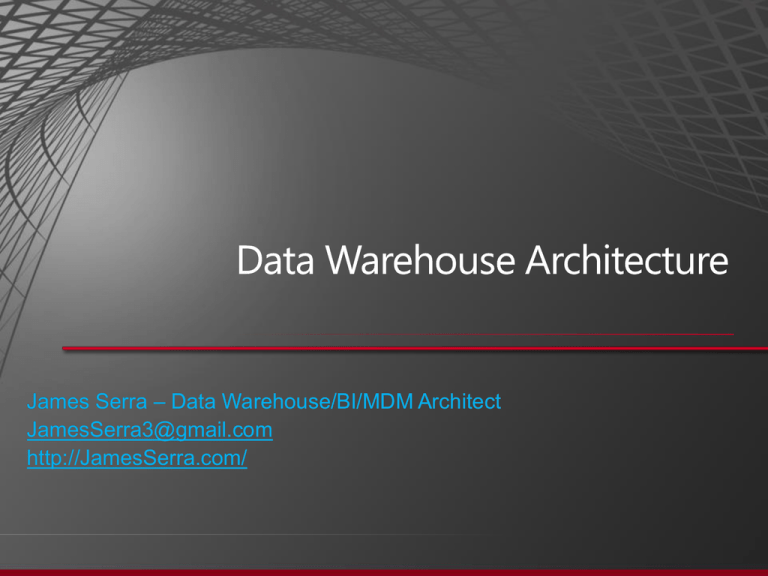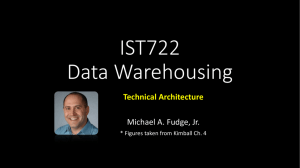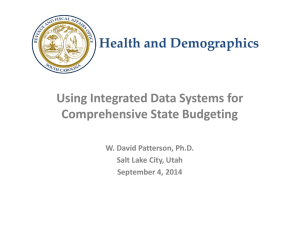Data-Warehouse-Architecture
advertisement

James Serra – Data Warehouse/BI/MDM Architect JamesSerra3@gmail.com http://JamesSerra.com/ • • • • • • • • Agenda Why use a data warehouse? Fast Track Data Warehouse (FTDW) Appliances Data Warehouse vs Data Mart Kimball vs Inmon (Normalized vs Dimensional) Populating a Data Warehouse ETL vs ELT Normalizing and Surrogate Keys SSAS Cubes SQL Server 2012 Tabular Model End-User Microsoft BI Tools • • • • • • • • • • Legacy applications + data marts = chaos Production Control MRP Inventory Control Parts Management Finance Marketing Sales Accounting Logistics Management Reporting Shipping Engineering Raw Goods Actuarial Order Control Purchasing Human Resources Enterprise data warehouse = order Continuity Consolidation Control Compliance Collaboration Single version of the truth Enterprise Data Warehouse Every question = decision • • Software: • SQL Server 2008 R2 Enterprise • Windows Server 2008 Configuration guidelines: • Physical table structures • Indexes • Compression • SQL Server settings • Windows Server settings • Loading Hardware: • Tight specifications for servers, storage and networking • ‘Per core’ building block • • • • • • • Data Warehouse vs Data Mart • − − − − • − Kimball vs Inmon Normalized (Inmon) vs Dimensional (Kimball) Normalized: Normalization rules Many tables using joins Dimensional: Facts and dimensions Less tables having duplicate data (de-normalized) Easier for user to understand Kimball vs Inmon Top-Down (Inmon) vs Bottom-Up (Kimball) Bottom-Up: Data marts Logical data warehouse Decentralized Quick results, iterative approach Top-Down: Enterprise data model Centralized Later create data marts More upfront work but less redo Populating a Data Warehouse Frequency of data pull Full Extraction – All data Incremental Extraction – Only data changed from last run Determine data that has changed Timestamp - Last Updated CDC Partitioning Triggers MERGE Online Extraction – Data from source Replication Database Snapshot Availability Groups Offline Extraction – Data from flat file ETL vs ELT Uses staging tables Processing done by target database engine (SSIS: Execute T-SQL Statement task instead of Data Flow Transform tasks) Use for big volumes of data Use when source and target databases are the same Use with PDW ELT is better since database engine is more efficient than SSIS Database engine: Transformations SSIS: Data pipeline and workflow management Normalizing and Surrogate Keys Normalize to eliminate redundant data and setup table relationships Surrogate Keys – Unique identifier not derived from source system SSAS Cubes Reasons to use instead of data warehouse: Aggregating (Summarizing) the data for performance Multidimensional analysis – slice, dice, drilldown Hierarchies Advanced time-calculations – i.e. 12-month rolling average Easily use Excel to view data Slowly Changing Dimensions (SCD) Data Warehouse Architecture SQL Server 2012 Tabular Model New xVelocity in-memory database in SSAS Build model in Power Pivot or SSDT Uses existing relational model No star schema, no extra SSIS Uses DAX Faster and easier to use than multidimensional model End-User Microsoft BI Tools Excel PivotTables SQL Server Reporting Services (SSRS) Report Builder PowerPivot PerformancePoint Services (PPS) Power View • • • • • • • • • • • • • • http://bit.ly/SrzNHy http://bit.ly/SrzX1x http://bit.ly/SrAi4p http://bit.ly/SrAwsj http://bit.ly/SrAEYw http://bit.ly/SrAIrp http://bit.ly/SrAHnc http://bit.ly/SrAKQa http://bit.ly/xAZy9h http://bit.ly/y7bXY5 http://bit.ly/SrARuZ http://bit.ly/SrAZug http://bit.ly/SrBMLT http://bit.ly/YQIXzM











